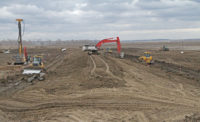A new 105,000-bpd hydrotreater will remove more sulfur and nitrogen from gas oil, and new tail-gas units will reduce sulfur compounds to levels consistent with emission regulations.
Project team members, including Flour Corp., Jacobs Engineering Group, Foster Wheeler USA Corp. and Praxair, have their work cut out for them, given that the Whiting facility encompasses a variety of process units, including alkylation, catalytic cracking, catalytic reforming, desulfurization, hydrogen, isomerization, thermal cracking/delayed coking and vacuum distillation. In addition to processing crude into gasoline and diesel, the plant produces aviation fuel, propane and 10% of all asphalt used in the U.S.
While Fluor is executing program and construction management, engineering, procurement, fabrication and construction under a contract valued at $3.8 billion, Jacobs is providing licensing, design and fabrication of sulfur recovery facilities. Foster Wheeler, meantime, is executing engineering, procurement, construction management and fabrication of the coking unit and gas plant facilities. Praxair is constructing a pair of hydrogen plants with a total capacity of 200 million standard cu ft a day.
Prior to the project, Whiting processed crude in roughly equal amounts from Canada, the Southwest and foreign and offshore domestic sources. Once the project is completed, BP plans to increase its use of Canadian crude to 80% to 90% from 30%—with a particular reliance on crude from the oil sands routed via a pipeline from Alberta to Illinois.
The upgrades will increase the BP refinery's capacity to process the heavy Canadian crude by 260,000 bpd and increase the facility's gasoline and diesel production by 675 million gallons a year—an amount sufficient to enhance plant profitability at a time when similar facilities have either closed or are on the selling block, as is the case with BP refineries in Texas and California.
"The profitability comes from upgrading heavier crude," says Shoriak. In addition to increasing its use of Canadian crude, the project will allow Whiting to accept a greater variety of crudes from other regions.
In the shorter term, the upgrades will help BP replace light-sweet crude, which has grown increasingly difficult to source.
The upgrades required BP to monitor the fabrication of equipment in Spain, Japan, the U.S. and other countries as well as modules constructed in South Carolina, Louisiana and the Philippines. Once completed, equipment was delivered to a new 54-acre barge that serves as an unloading facility along the Indiana Harbor Ship Canal in East Chicago.






